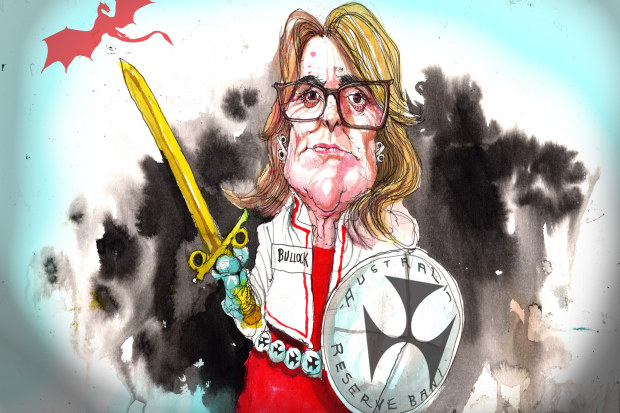There’s an $80b spending bomb buried in the budget
Jim Chalmers has used an old budget trick to bury a further $80 billion of outlays.
John KehoeEconomics editorThe people who should be most worried about this profligate pre-election budget are Reserve Bank governor Michele Bullock and home loan borrowers.
Treasurer Jim Chalmers is kitchen sinking this Labor budget. He is front loading over the next two years more than 80 per cent of the net $24 billion of extra policy spending, the budget’s so-called “table of truth” reveals.
Surprisingly, every household – even high-income earners – will receive a $300 energy bill rebate at a cost of $3.5 billion. Raising rent assistance by 10 per cent will inject an extra $1.9 billion into households.
Reserve Bank governor Michele Bullock should be worried about this big-spending budget. David Rowe
While the government claims this will reduce headline inflation by 0.5 of a percentage point in the short term, every economist and their pet shop galah says the money will end up elsewhere in the economy and add to overall inflation pressures.
Chris Richardson says the Albanese government has failed the test on “poking the inflation bear”. It compounds expansionary state budgets in Queensland, Victoria and Western Australia that added $9 billion to the inflation bonfire through things such as energy bill rebates and payments to parents of public school students.
The government’s cost-of-living subsidies are a relatively small share of the economy, but they are only the start of the pre-election spendathon, such as Future Made in Australia subsidies for green hydrogen, critical minerals and solar panels.There are also billions more for upgrades to myGov, government IT systems and expiring health programs. While this spending may be an “unavoidable” cost of running government, there are no major savings offsets, so the next decade of budget deficits will be bigger.
Overall, real spending (even discounting for high inflation) is forecast to grow 4.5 per cent this year and 3.6 per cent next year before any more election goodies. This is double the 2 per cent spending growth cap that Chalmers’ old boss, former treasurer Wayne Swan, set as a budget rule 15 years ago. There is no such restraints on this government. It lacks fiscal guardrails.
Accelerator battles brake
A $20 billion discretionary spending jump combined in 2024-25 and 2025-26 is on top of the $22 billion unleashed in last year’s budget over two years.
All up, it amounts to a net policy spending injection of $42 billion, or almost 2 per cent of GDP.
At a time when inflation is above target and the RBA is contemplating if it may need to add to its 13 interest rate rises, this is a notable fiscal spending injection into an inflationary economy.
Treasury is worried the economy is weaker than the RBA thinks, so Labor is content to press a bit on the fiscal pedal, while the central bank keeps the foot firmly on the brake.
The budget forecasts slightly higher unemployment (4.5 per cent versus the RBA’s 4.3 per cent by next year) and lower inflation. Politically, it keeps alive Labor’s hope of an interest rate cut before an election is due by May next year.
But most economists will judge the budget as more stimulatory than almost anyone expected, and may up their bets of higher-for-longer interest rates.
Richardson estimates that for every $7 billion in additional government spending, the RBA needs to lift the cash rate 0.25 of a percentage point higher than otherwise.
Finally, Chalmers has used an old budget trick to bury a further $80 billion of outlays not already mentioned.
Richardson says it’s the most “obscure” number in the budget, but is now perhaps the most important.
Funding injections into specialist investment vehicles include money for a Future Made in Australia, the Clean Energy and Finance Corporation ($19.3 billion), Snowy Hydro ($7.3 billion), student loans ($16.2 billion), National Reconstruction Fund loans and investments ($7.2 billion) and Housing Australia ($6.5 billion).
A further $17.7 billion is buried under “commercial-in-confidence” for projects such as Western Sydney Airport and AUKUS.
It’s spending funded by borrowed money, but is put in a place in the budget that most people don’t look.
— Saul Eslake, economist
Conveniently, the so-called “off budget” spending will not hit the underlying profit and loss bottom line that most analysts focus on.
The “net cash flows from investments in financial assets for policy purposes” is an old sleight of hand used by treasurers.
But Labor has ramped it up, from $34 billion before the 2022 election to $51 billion last year, to a record $80 billion in this budget over five years.
Economist Saul Eslake says: “It’s spending funded by borrowed money, but is put in a place in the budget that most people don’t look.”
The budget lists these investment vehicles in the “statement of risks” and the International Monetary Fund has warned about their proliferation.
Adding in the $80 billion for investment vehicles, the cumulative five-year “underlying” cash deficit jumps from $113 billion to a “headline” deficit of $193 billion.
After a taste of surpluses, it’s back to a decade of budget red ink.
- Forums
- Political Debate
- Albo's Government is heading to a $193bil deficit
Albo's Government is heading to a $193bil deficit, page-21
-
- There are more pages in this discussion • 104 more messages in this thread...
You’re viewing a single post only. To view the entire thread just sign in or Join Now (FREE)
Featured News
Featured News
The Watchlist
I88
INFINI RESOURCES LIMITED
Charles Armstrong, CEO & Managing Director
Charles Armstrong
CEO & Managing Director
SPONSORED BY The Market Online






